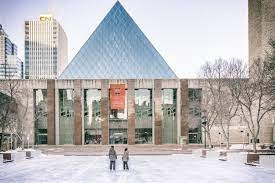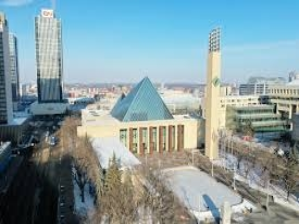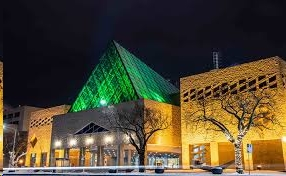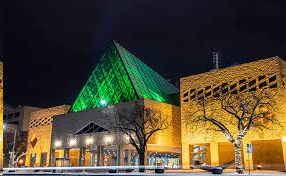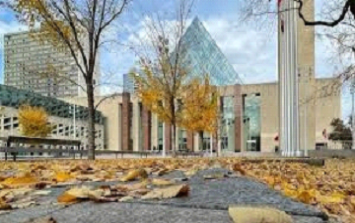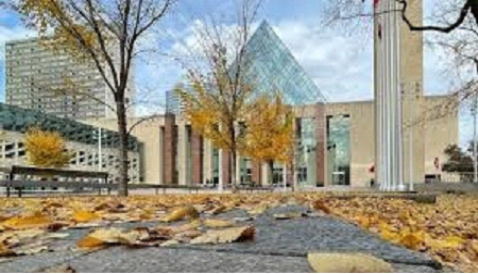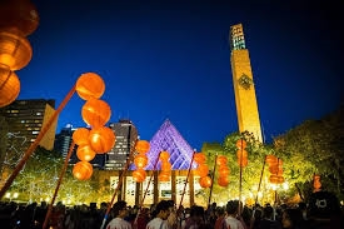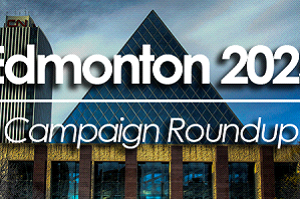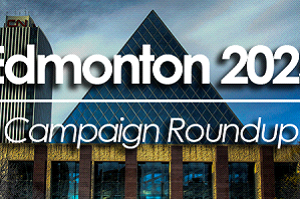ON THE AGENDA
Stephanie Swensrude
Before heading into the holiday break, Edmonton city council is scheduled to debate rezoning applications and interview candidates for the Edmonton Police Commission.
A public hearing is scheduled on Dec. 15, a council meeting on Dec. 16 and 17, and an orientation meeting on Dec. 17. Then, aside from a bit of agenda review in the new year, council resumes its regular meeting schedule on Jan. 19.
Here are some key items on the agenda:
- The City of Edmonton has applied to rezone the open space adjacent to the St. Peter Centre at 7330 113 Street NW to allow for a medium-scale residential building. If the application is approved, the city said it plans to sell the land to an affordable housing provider. The site is adjacent to a bus stop and less than 300 metres from the McKernan/Belgravia LRT Station. Some nearby residents said they oppose the application because they want to see the green space retained for soccer. Council is scheduled to debate the application on Dec. 15.
- More than 100 people said they oppose a rezoning application in Crestwood at 14603 95 Avenue NW. Franken Homes has applied to rezone the corner lot from the small-scale residential zone to the small- to medium-scale transition residential zone, which would allow for the building to be 1.5 metres taller and cover 60% of the lot instead of 45%. Those opposed to the rezoning application said the current RS zone is sufficient and that there is too much infill in the neighbourhood. They also raised concerns about parking, traffic, and the neighbourhood’s character. Administration said it supports the application because the location is appropriate for a larger building. Council is scheduled to debate the rezoning application at a public hearing on Dec. 15.
- The Michael Pavone Realty Group has applied to rezone a property in Queen Alexandra at 10541 81 Avenue NW to allow for a six-storey mixed-use building. The rezoning would remove the requirement for the property to have commercial bays facing the street and would allow for ground-floor residential. Council is scheduled to debate the rezoning application at a public hearing on Dec. 15.
- Council is to meet in private on Dec. 16 to interview candidates for the Edmonton Police Commission and Edmonton Regional Airports Authority.
- Council will learn more about safety and security, as well as public engagement, at an orientation meeting on Dec. 17
~~~~~~~~~~~~~~~~~~~~~~~~~~~~~~~~~~~~~~~~~~~~~~~~~~~~~~~~~~~~~~~~~~~
- There will be a City Council meeting on Tuesday at 1:30 pm. There are several Motions Pending to be reviewed. Councillor Clarke plans to move two motions: one requesting a comprehensive analysis of potential City partnerships and sponsorships beyond naming rights, including revenue impacts and policy adjustments, and another analyzing Edmonton’s tax competitiveness compared with other Canadian municipalities, assessing effects on industrial investment, business attraction, and economic growth. Councillor Morgan intends to request a report evaluating the outcomes of the Permanent Enhanced Cleaning program on transit, including timelines and metrics for success. Councillor Stevenson has two motions: one seeking a report on one-time multi-year programs, grants, and initiatives ending with the 2023-2026 budget, and another requesting an update on the Integrated Call Evaluation and Dispatch initiative, detailing how funding from the Community Safety and Well-Being Strategy has supported integrated dispatch.
- Some Councillors are raising concerns that ward budgets haven’t been updated in 13 years, leaving each of the 12 wards with only about $205,000 to engage with residents, compared with Calgary’s $350,000 per ward for 15 wards. Councillor Aaron Paquette noted that inflation, population growth, and evolving technological and equity needs have made the outdated funding insufficient, limiting offices’ ability to communicate with constituents and provide services such as newsletters or accessibility supports. Council has asked Administration to review ward budgets and the Mayor’s Office funding and provide a detailed service package for consideration. In addition to core funding, Councillors requested office furniture and travel budgets for 2026, including attendance at conferences, advocacy days, and government events such as the Calgary Stampede. Total approved furniture costs for the year came to $11,178, with remaining 2025 budget funds potentially carried forward.
- Council has approved $11 million in annual funding for Explore Edmonton, the City’s tourism agency, along with an additional $2.5 million over three years to support a yet-to-be-named major event bid. Council emphasized the economic benefits, with Mayor Andrew Knack noting the city expects to see $29 back for every dollar invested. Explore Edmonton says that tourism has become a major economic driver, with the city hosting over 80,000 overnight visitors during the Oilers’ Stanley Cup run in 2024. The organization also manages the Edmonton Expo Centre, Convention Centre, and major annual events like K-Days and the Canadian Finals Rodeo.
- The City of Edmonton has begun demolishing the historic Northlands Park Racetrack and Casino to make way for a large residential development on the 220-acre Exhibition Lands site. The project will include 3,500 multi-family and rowhouse units, potentially housing up to 7,500 residents, and is part of a broader City plan that also involves a new fan park and eventual redevelopment of the Northlands Coliseum. Positioned just five kilometres from downtown and near the river valley, the area will be a transit-oriented urban village served by two LRT stations. Demolition is scheduled to finish in spring 2026, with construction on residential parcels starting soon after and some units expected by 2027. The development is expected to unfold over the next two decades, with a market-driven approach guiding residential and commercial construction.
- Edmonton commuters and nearby businesses are seeing relief as 104 Avenue between 105 Street and 121 Street has reopened to two lanes in each direction, marking the completion of the 2025 accelerated Valley Line West roadwork plan. The project, which began in mid-April, involved upgrades to six major intersections along the future LRT line and finished on or ahead of schedule. City crews removed barricades and restored full traffic flow, setting permanent turning options for motorists in completed areas. Officials acknowledged the disruption caused by months of construction and thanked the public for their patience. Planning for the 2026 construction season is already underway, and details on next year’s work will be shared once finalized. The Valley Line West LRT itself remains on track for completion in 2028, after which extensive testing will be conducted before opening to passengers.
City Council has finalized Edmonton's 2026 budget - and despite months of warnings from residents, they increased the property tax hike beyond what was originally presented.
The originally expected 6.4% increase was bumped up to 6.9%!
The City's total budget has now reached $6 billion, with a $3.93-billion operating budget and a $2.3-billion capital budget.
While inflation and population pressures were cited as drivers of this increase, many of the increases were the result of political decisions rather than unavoidable costs.
Here is where some of your money went:
- Explore Edmonton: $11 million in additional ongoing funding to attract major events
- Bus Cleaning: $2.7 million in ongoing funding to permanently enhance cleaning on buses
- City Operations: $900 million total, covering transit, road plowing, snow clearing, and other essential services.
- Policing: $628 million to fund Edmonton Police Service operations.
- Bus Purchase: $25.2 million to purchase 25 new buses in high-demand areas
Now, the final tax hike of 6.9% might seem high (and it is!), but - believe it or not - it could have been even worse!
Edmonton’s Financial Stabilization Reserve remains below its minimum target, and Councillor Aaron Paquette proposed a dramatic “rip off the Band-Aid” approach of putting $64.5 million toward restoring the Reserve to its minimum this year.
If his motion had passed, the property tax increase for 2026 would have jumped to over 9%!
Paquette argued this would have allowed the city to have much lower tax increases in future years.
But that's like trying to argue it's a good thing if grocery prices go up by 10% today, instead of going up by 10% in a few years' time.
Thankfully, Council rejected the motion.
Unfortunately, Council also rejected basically every proposal to reduce spending and reduce the tax increase.
Councillor Karen Principe proposed reducing corporate expenditures by $4.7 million, scaling back vandalism control efforts to shave off $2.1 million, and using more of the EPCOR dividend to lower the tax hike by $5 million.
In the end, the budget passed 11-2, with Councillors Michael Elliott and Karen Principe opposed.
In the end, the message is simple - City Hall is continuing to raise taxes and spending faster than ever, without regard for whether Edmontonians can afford to pay.
At Common Sense Edmonton, we track Council decisions, expose wasteful spending, and push for responsible budgeting.
It seems like we will have our work cut out for us over the next four years.
On The Agenda
- Councillors are set to learn more about how the City of Edmonton would respond to an emergency situation at an emergency advisory committee meeting on Dec. 12. The committee will be asked to approve the municipal emergency plan, which has been comprehensively updated for the first time since 2021. The new plan includes a preliminary evacuation plan, which is the first step toward a full evacuation plan that’s required due to changes in the provincial Emergency Management Act. It also includes changes that expedite agreements between Edmonton and other municipalities for large-scale evacuations, like those that occurred during the wildfire seasons of 2023 and 2024.
- Councillors have requested $55,500 to attend conferences and other meetings in 2026, according to a report set to be presented to council services committee on Dec. 12. Travel and registration fees are funded by a budget the 12 councillors share, which is $73,000 in 2026. Coun. Keren Tang and Coun. Mike Elliott has each requested to attend the Calgary Stampede in June at a cost of $2,000 and $3,000, respectively. Coun. Jon Morgan has requested to attend three Canadian Urban Transit Association events at a total cost of $13,000. There is $17,500 set aside for all the councillors to attend the Federation of Canadian Municipalities in Edmonton in June.
- Councillors have requested a total of $11,578 for new office furniture, according to a report set to be presented to council services committee on Dec. 12. Office furnishings like workstations and chairs are funded by a budget the 12 councillors share, which is set at the first council services committee meeting of the year. The requests would result in a negative balance of $300, but the report said some requests would be able to be billed to the 2025 fiscal year.
- Administration is scheduled to present the external auditor’s 2025 report to council’s audit committee at a meeting on Dec. 10. The report details KPMG’s plan to audit the consolidated financial statements of the City of Edmonton for 2025.
- Administration will present the proposed boards of directors and budgets for the city’s business improvement areas for 2026 at a council meeting on Dec. 8.
- Council is scheduled to receive a private update on an unspecified event and on a confidential negotiation at a council meeting on Dec. 8.
- Councillors are set to learn more about how the City of Edmonton would respond to an emergency situation at an emergency advisory committee meeting on Dec. 12. The committee will be asked to approve the municipal emergency plan, which has been comprehensively updated for the first time since 2021. The new plan includes a preliminary evacuation plan, which is the first step toward a full evacuation plan that’s required due to changes in the provincial Emergency Management Act. It also includes changes that expedite agreements between Edmonton and other municipalities for large-scale evacuations, like those that occurred during the wildfire seasons of 2023 and 2024.
- Councillors have requested $55,500 to attend conferences and other meetings in 2026, according to a report set to be presented to council services committee on Dec. 12. Travel and registration fees are funded by a budget the 12 councillors share, which is $73,000 in 2026. Coun. Keren Tang and Coun. Mike Elliott has each requested to attend the Calgary Stampede in June at a cost of $2,000 and $3,000, respectively. Coun. Jon Morgan has requested to attend three Canadian Urban Transit Association events at a total cost of $13,000. There is $17,500 set aside for all the councillors to attend the Federation of Canadian Municipalities in Edmonton in June.
- Councillors have requested a total of $11,578 for new office furniture, according to a report set to be presented to council services committee on Dec. 12. Office furnishings like workstations and chairs are funded by a budget the 12 councillors share, which is set at the first council services committee meeting of the year. The requests would result in a negative balance of $300, but the report said some requests would be able to be billed to the 2025 fiscal year.
- Administration is scheduled to present the external auditor’s 2025 report to council’s audit committee at a meeting on Dec. 10. The report details KPMG’s plan to audit the consolidated financial statements of the City of Edmonton for 2025.
- Administration will present the proposed boards of directors and budgets for the city’s business improvement areas for 2026 at a council meeting on Dec. 8.
- Council is scheduled to receive a private update on an unspecified event and on a confidential negotiation at a council meeting on Dec.8.
~~~~~~~~~~~~~~~~~~~~~~~~~~~~~~~~~~~~~~~~~~~~~~~~~~~~~~~~~~~~~~~~~~~~~~~~~~
- Edmonton City Council has approved a 6.9% property tax increase for 2026 following four days of budget deliberations. The budget passed with an 11-2 vote - Councillors Mike Elliott and Karen Principe were opposed. This is higher than the 6.4% increase initially proposed and includes funding for tourism marketing, transit cleaning, new buses, and additional peace officers for traffic safety. Council also approved $7.3 million for road upgrades in west Edmonton in partnership with the provincial government and Enoch Cree Nation, as well as expanded use of the derelict residential tax subclass to encourage property revitalization. The City says the tax increase addresses structural budget variances caused by high costs, rapid population growth, and changing service needs. Tax assessments will be released in January, with notices mailed in May.
- During budget debates, Councillor Aaron Paquette proposed a plan to restore $64.5 million to the City’s financial stabilization reserve, which would have pushed taxes above 9% this year but lowered increases in future years - his motion was defeated 12-1. Funding for Explore Edmonton was approved 8-5, with Councillors Reed Clarke, Thu Parmar, Karen Principe, Michael Elliott, and Mayor Andrew Knack voting against. Councillor Karen Principe also proposed several motions to cut spending and reduce taxes, including reallocating funds from contractual items, vandalism control, and the EPCOR dividend, but all were defeated.
- The Emergency Advisory committee meets on Friday this week to review the City’s updated 2026 Municipal Emergency Plan, a major revision that adds new evacuation planning requirements, updated emergency social services standards, and streamlined procedures aligned with recent provincial legislation. The meeting includes a full briefing on how Edmonton manages prevention, preparedness, response, and recovery efforts during disasters such as wildfires, floods, hazardous materials incidents, and large-scale evacuations. A key spending item is the requested budget increase for the Emergency Management Program, including six additional full-time staff positions costing $927,074 annually to meet new provincial requirements and support emergency readiness. Council members will also receive mandatory training updates required under Alberta’s emergency management regulations.
- The Edmonton Police Service has become the first police agency in the world to test Axon’s new body-worn cameras equipped with facial recognition. Up to 50 officers will use the cameras in a month-long trial to evaluate whether the technology can accurately match faces captured on video with EPS’s existing database, including individuals flagged for safety concerns or with serious outstanding warrants. The system runs in “silent mode,” meaning officers will not receive real-time alerts. Instead, specialized staff will review footage afterward to assess accuracy and operational impact. EPS says all facial-recognition still images will be deleted after testing, with video retained under standard rules. Officials describe the trial as an exploration of whether the technology can enhance public and officer safety, while stressing it will not replace human judgment. Results will be reviewed by the Edmonton Police Commission in 2026, and a Privacy Impact Assessment has been submitted to the provincial commissioner.
- The Alberta government has entered negotiations with the top-ranked bidder to redevelop the former Royal Alberta Museum site in Edmonton’s Glenora neighbourhood. The move follows a shift from last year’s plan to demolish the vacant 1967 building and convert the area into park space. Six proposals were submitted, three met provincial criteria, and one has now advanced to early negotiations. The building currently costs about $700,000 annually to maintain and carries an estimated $225 million in deferred maintenance and renovation needs. Community groups and local MLAs have long urged preservation of the structure, pointing to strong public support in earlier surveys. The Province says more details will be released if negotiations succeed, with the option of approaching the next-ranked proponent if required.
ON THE AGENDA
Stephanie Swensrude
This week, council will deliberate over changes to the fall budget adjustment at a council meeting scheduled for Dec. 1, 2, 3, and 4.
City administration has proposed a 6.4% property tax increase for 2026, in line with what the previous council approved in the spring. The current council questioned administration about the budget during a meeting on Nov. 25.
Administration has identified a $52.3-million gap in the operating budget. City staff have shifted money around internally to address $13.4 million of that gap, and said in a report that the remaining $38.8 million will “be addressed through specific action plans, which include fee increases, program reviews, and adjustments to service levels.”
Council will debate whether to fund several currently unfunded budget service packages, including $1.9 million to staff transit stations with safety attendants during periods of lower ridership, $95,000 to support expanding the derelict residential tax subclass beyond mature neighbourhoods, $2.7 million to make a temporary enhanced transit cleaning program permanent, $9.9 million to improve snow clearing and sidewalk repair, $555,000 to reinstate the infill liaison team, and $2.9-million to improve DATS service levels.
Meanwhile, three capital projects require more money than previously approved in the four-year budget cycle. The estimated cost for the 137 Avenue and Anthony Henday Ramps project has more than doubled, from $6.6 million to $14.3 million. Construction of the Athlone Fire Station is now expected to cost $28 million, or $10 million more than its original allocation. Costs to build the Walker Fire Station have increased, too, from $19.9 million to $32.8 million. About $3 million of the increase is attributed to construction, while an additional $10 million is needed because the project is now proposed to include an emergency communications dispatch centre.
Coun. Keren Tang, whose ward includes the future Walker Fire Station, said the stations are necessary, but that she’s worried infrastructure costs are ballooning with every budget. Tang said the increase that’s proposed has come as a surprise, too. “We approved $19.9 million, which is not a small number, and the ground hasn’t been broken yet, I haven’t seen any designs, I haven’t seen much engagement on this, and now we’re asking for an additional $12 million,” Tang said. “That’s a lot.”
Council will also debate purchasing 25 new buses, for $25.22 million, to transition three On Demand Transit zones to scheduled service. This change would result in a $420,000 operating budget increase in 2026, and about $7.4 million annually starting in 2027, the year the buses are expected to enter service.
The agenda includes a report that suggests the removal of most photo radar sites coincides with an increase in speeding, especially drivers travelling at 20 to 30 km/h over the posted limit. The previous council asked for this report, to outline ways the city could increase safety enforcement. That report notes the number of speeding vehicles has increased by nearly 11% in 2025 compared to 2024. The largest increase, it notes, is among vehicles travelling at 20 to 29 km/h over the speed limit, which grew by 87.3%.
The report also includes an update on the city’s progress on Vision Zero. That plan targets eliminating traffic fatalities and serious injuries by 2032, and was adopted in 2015. In the first four years, traffic deaths and serious injuries decreased by 50% and 32%, respectively. In 2020 and 2021, during the COVID-19 pandemic, fatalities and injuries continued to drop. But fatalities have climbed rapidly in recent years. Fourteen people died in traffic-related events in 2019, growing to 24 in 2023 and 26 in 2024. So far in 2025, 31 people have died in traffic-related events. Speed has been a contributing factor in about half of those fatalities, according to Edmonton Police Service data. Council is set to debate an enhanced traffic safety enforcement strategy during budget deliberations.
Meetings stream live on YouTube on the Chamber channel and River Valley Room channel.
*******************************************************************************************
- City Council will meet several times this week to discuss the 2025-2028 budget, starting today at 9:30 am. Councillors are set to review the proposed 2026 budget, which includes a 6.4% property tax increase, matching the previous Council’s spring approval. Administration cites a fiscal gap caused by declining provincial grants, a shrinking share of non-residential taxes, debt limits, inflation, and population growth, making it challenging to maintain service levels.
- Despite the tax increase being debated, concerns remain that critical arterial roads may not be repaired due to insufficient funding. Councillor Keren Tang proposed adding $5 million - the lowest funding option - to extend the service life of the worst-condition roads, emphasizing that maintaining existing infrastructure is a core service and cheaper than letting deterioration worsen. Residents have expressed frustration with patchwork repairs, urging the city to address long-term road quality. Mayor Andrew Knack acknowledged the importance of roadwork but indicated that additional funding may have to wait until the next four-year budget cycle.
- Municipal Affairs Minister Dan Williams told the Edmonton Chamber of Commerce that municipalities must focus on core services and avoid spending on extras, stressing that the province is not a “shining knight” for City finances. Edmonton receives about $250 million from the provincial government, which fluctuates with revenues, so Williams urged Councils to deliver essential services like road maintenance, water systems, and garbage collection efficiently. He encouraged innovative solutions to help municipalities manage budgets without raising property taxes, emphasizing long-term infrastructure planning and asset use. Williams also stressed that addiction and social disorder are primarily provincial responsibilities, with the Alberta Recovery Model guiding compassionate intervention for those struggling with addiction. While municipalities should cooperate with provincial strategies, they must respect the mandated approach and avoid duplicating services. Overall, Williams called for fiscal responsibility at the municipal level while supporting coordinated provincial-municipal efforts on social challenges.
- Edmonton is moving ahead with 10 new affordable-housing developments after selling surplus school sites to builders for a symbolic one dollar each. The projects are funded through a $99-million federal Housing Acceleration Fund grant and will add more than 1,300 units across the city, including 925 below-market homes capped at 80% of average rents. Sites in neighbourhoods such as Belmont, Blue Quill, Dunluce, Miller, and Summerlea will host a range of purpose-built housing, from multi-generational units to second- and third-stage housing for women and families leaving violence. Several projects include partnerships with community groups, Indigenous organizations, and newcomer-serving agencies. City officials say the initiative will make a meaningful contribution to Edmonton’s affordable-housing shortage, while the province has opened a new $200-million funding round through its Affordable Housing Partnership Program. The remaining surplus school lands continue to be evaluated for future housing opportunities.
- The Province has selected a location on the University of Alberta’s south campus for a new standalone Stollery Children’s Hospital, marking the first major step toward expanding pediatric care in the capital region. The site, currently a green space near 122 Street and 51 Avenue, was chosen for its room to grow and its proximity to the university’s clinical and research hub. Detailed planning for space, services, and infrastructure will continue until 2026, with costs and timelines to be determined afterward. Construction of a full hospital is expected to take at least five to eight years once it begins. The Stollery Children’s Hospital Foundation has launched a $1-billion fundraising campaign to support the project. Once complete, the facility is expected to free up space at the existing Stollery within the University of Alberta Hospital, helping meet growing acute care demands in a city that has added more than 300,000 residents since the original Stollery opened in 2001.
At Common Sense Edmonton, we’re always encouraging more people to get involved in shaping our city - whether that means running for office, supporting a campaign, or simply paying attention to what’s happening at City Hall.
But anyone who has been around politics knows the truth: it’s not easy to put your name forward, and it’s even harder when things don’t go your way.
That’s why we’re sharing an upcoming event from our friends at the Doing It Right Women’s Initiative that highlights the real experiences of political participation.
Their "After the Race" will bring together a variety of women who ran in the last municipal election but didn’t win.
Instead of glossing over the experience, they’ll share what actually happens when you take the risk, face the pressure, deal with setbacks, and decide whether to try again.
While the event is put on by a women’s organization, everyone is welcome.
If you’ve ever thought about running for office yourself, or you simply want a better understanding of what local politics demands from ordinary citizens, this is an opportunity to hear real stories, ask questions, and learn from experience.
When: Thursday, November 27th from 6:00 pm - 8:00 pm
Where: Hudsons Canada's Pub on Whyte - 10307 82 Ave NW (18+)
Tickets ($24.99) include a drink ticket, appies, and plenty of engaging conversation - a great way to spend an evening learning about campaigns.
Edmonton benefits when more people are willing to step up, share ideas, and get involved.
Whether you’re thinking about running yourself or just want an honest look behind the scenes, this evening will surely be interesting!
Hope to see you there!
- Common Sense Edmonton
This week, council will get its first look at the fall budget adjustment and will continue with orientation.
There is an orientation meeting scheduled for the mornings of Nov. 24, 25, and 26, and a city council meeting scheduled for the afternoons of Nov. 24, 25, and 26.
Council will review the fall budget adjustment at the afternoon meetings. Administration has proposed a 6.4% tax increase for 2026, which is in line with what the previous council approved in the spring.
Administration has identified a $52.3-million gap in the city’s operating budget. City staff moved money around internally to address $13.4 million of the gap, and the remaining $38.8 million will “be addressed through specific action plans, which include fee increases, program reviews, and adjustments to service levels,” the budget report said. Administration has proposed reducing the budget of the city’s anti-racism office by $430,000. Other proposed service reductions will be discussed in private.
Council will debate budget service packages that are currently not funded, including $1.9 million to staff transit stations with safety attendants during periods of lower ridership, $95,000 to support expanding the derelict residential tax subclass beyond mature neighbourhoods, $2.7 million to make a temporary enhanced transit cleaning program permanent, $9.9 million to improve snow clearing and sidewalk repair, $555,000 to reinstate the infill liaison team, and a $2.9-million funding increase to improve service levels with DATS.
Meanwhile, three capital projects require more than what was already approved in the four-year budget cycle. The estimated cost for the 137 Avenue and Anthony Henday Ramps project has more than doubled, from $6.6 million to $14.3 million. Construction of the Athlone Fire Station is now expected to cost $28 million, or $10 million more than its original allocation. Construction of the Walker Fire Station has increased, too, from $19.9 million to $32.8 million.
Council will debate purchasing 25 new buses, for $25.22 million, to transition three On Demand Transit zones to scheduled service. This change would result in a $420,000 operating budget increase in 2026, and about $7.4 million annually starting in 2027, the year the buses are expected to be put into service.
The budget report also includes an update on the Old Strathcona Public Realm Strategy. Council had asked administration to establish a reserve fund so that parking revenues from the ePark lot across Gateway Boulevard from the Old Strathcona Farmers’ Market would be used to support the upgrades identified in the strategy, including design and construction of upgrades to End of Steel Park. Administration forecasts that the parking revenues will be able to fund the design of the park, but not the construction or any other upgrades in the strategy.
The carbon budget report said the proposed adjustments aren’t expected to significantly change the city’s emissions. The city is still forecast to deplete its community carbon budget in 2036 and its corporate carbon budget in 2032. Its stated goal is to be carbon-neutral by 2050.
FLFLFLFLFLFLFLFLFLFLFLFLFLFLFLFLFLFLFLFLFLFLFLFLFLFLFLFLFLFLFL
- Today, at 8:30 am, there will be special meetings of the Community and Public Services Committee, the Executive Committee, and the Urban Planning Committee. The Committees will each elect a Chair and Vice-Chair, but there is little else on the agenda. At 9:30 am, City Council Orientation continues, and Councillors will receive presentations from Administration on Supporting Financial Sustainability. Tuesday’s orientation session will focus on Economic Development, on Wednesday Council will hear about Service Delivery and Advancing Safety and Security.
- Council budget meetings will also begin today, at 1:30 pm, and continue on Tuesday at 1:30 pm and Wednesday at 1:30 pm, as well as December 1st to 4th beginning at 9:30 am each day. Edmontonians are facing a 6.4% property tax increase, which Administration says is needed to address the City’s growing fiscal pressures from inflation, population growth, declining provincial grants, and debt limits. Many planned capital projects, including new buses and road expansions, have been left unfunded, though $6.5 million is allocated for the Rossdale Power Plant roof. Officials warn that any reductions to offset the tax hike would likely come at the expense of service levels. The budget marks the final year of the current four-year cycle, with the new Council expected to draft a fresh budget in 2026.
- Edmonton is facing a rise in traffic fatalities, with 30 deaths so far this year, up from 26 in 2024 and 24 in 2023. Nearly half of these collisions involved speeding, and excessive speed violations over 50 km/h above the limit are up 19%. Street racing and reckless driving are also reportedly contributing to the problem. Police stress that automated enforcement could reduce dangerous driving, but high-risk intersections remain a concern. Most fatal crashes occur on arterial roads and during darkness, with speed being the key factor. The City is targeting priority areas, such as 118 Avenue near Highlands School, using measures like flashing beacons, which have cut average speeds by 14%. Despite these efforts, officials warn that speeding and traffic fatalities continue to pose a serious threat to public safety.
- Edmonton Ward Dene Councillor Aaron Paquette is proposing to turn the City’s ED Tel Endowment Fund into a sovereign wealth fund to reduce reliance on property taxes and attract more development. The fund, currently worth $1 billion, generates about $48 million annually for property tax relief, but Paquette aims to grow it to $6 billion over 10-15 years to fully offset tax increases. He argues the City has already squeezed all efficiencies from its budget and needs alternative revenue streams. Concerns have also been raised that businesses are moving just outside Edmonton to avoid high taxes, leaving the City to shoulder rising costs. Paquette suggests the City offer incentives and better infrastructure support to attract developers while including safeguards to protect taxpayers.
- Former Mayoral candidate Tim Cartmell has announced he is leaving the Better Edmonton Party, which he co-founded during last year’s municipal election. Cartmell said he decided to step back after a period of reflection but praised the remaining team for continuing to push core issues and potentially prepare for the next election. The party saw three Councillors elected in October, though two of them recently left the party as well. Cartmell expressed pride in the campaign’s accomplishments and in his eight years of service on City Council, calling it an enriching experience despite the recent departures.
This week, Edmonton’s new city council is scheduled to hold its first public hearing of the term to consider rezoning applications, and discuss partnerships with the private sector.
There is an orientation meeting scheduled for Nov. 17, a council meeting scheduled for Nov. 18, and a public hearing scheduled for Nov. 19.
- Administration is scheduled to give presentations on the following topics on Nov. 17 and 18: The city structure, city culture, and City Plan; the fundamentals of finance, taxation, and reporting; and growth planning.
- The Canada Palestine Cultural Association’s Edmonton chapter has applied to rezone its building located in the Peter Lougheed Multicultural Village to allow for childcare, food and drink services, and limited retail. The CPCA building is located at 13312 142 Street NW, next to several other community centres such as the Italian Cultural Centre, the Sri Guru Nanak Sikh Gurdwara of Alberta, the Hindu Society of Alberta, the Jain Society of Alberta, and Chrysalis: An Alberta Society for Citizens with Disabilities.
- Council will consider a report that proposes more city partnerships with the private sector to build future infrastructure, including arenas and libraries, on Nov. 18. The strategy aims to address the city’s growing population and challenges in maintaining and expanding needed facilities. Administration identified the Woodcroft Library renewal, Cumberland Fire Station, Windermere North Transit Centre, and various arenas as potential collaboration projects.
- MJD Childcare has proposed to rezone a site that’s home to Elks Lodge No. 11, which the Elks of Canada fraternity organization established around 1959. The lot is located at 11823 129 Avenue NW, kitty-corner to a commercial area. MJD Childcare proposes to rezone the lot from the small-scale residential zone to the neighbourhood mixed-use zone, which would allow for a multi-unit, mixed-use building of up to four storeys.
- Council is scheduled to review a rezoning application for two houses located at 10421 and 10417 70 Avenue NW, respectively, in the Allendale neighbourhood. Polar White Investments has proposed the land be rezoned as the medium-scale residential zone, which would allow for a building of up to four storeys and limited community and commercial uses. Three people expressed opposition to the application, suggesting a four storey building would be too tall, and that the development would lead to parking and traffic congestion. Administration said it supports the application because a four-storey building would act as a transition at this location.
- A landowner has applied to rezone a property in Belvedere at the corner of 66 Street NW and 134 Avenue NW to allow for a building of up to four storeys. Administration said it supports the application because it will add additional density on a corner of an arterial and collector roadway. Twelve residents expressed opposition to the application, noting the potential impacts on the long-term residential rental tenants who live on the existing site, the report said.
- Council will receive a private update on intergovernmental relations and on procurement at a meeting on Nov. 18.
Meetings stream live on YouTube on the Chamber channel and River Valley Room channel.
##############################################################################################################
- City Council will meet on Tuesday at 9:30 am. On the agenda is a report suggesting the City could consider more public-private partnerships to help build future infrastructure, including new arenas, a renewed Woodcroft Library, the Cumberland Fire Station, and the Windermere North Transit Centre. City Administration says these partnerships may help Edmonton keep up with growth while managing rising costs. Former Councillor Tim Cartmell argued private partners can design, build, and finance projects, with the City leasing only the portion it needs. He says combining uses, such as adding retail or housing alongside an arena, could make projects more affordable. Cartmell also suggested using existing vacant retail or City-owned space instead of building entirely new structures. Councillor Michael Janz says he is open to reviewing proposals but cautioned that private profit should not override public interest, noting the City often borrows at lower rates than private companies.
- Council will also review the process for the 2025 Fall Supplemental Budget Adjustments, which cover Capital, Operating, and Utilities budgets for the 2023-2026 cycle. Budget reports will be released on November 20th with presentations being made to Council on November 25th and 26th. Final deliberations and amendments will occur during the December 1st to 4th meeting. The process includes a structured amendment procedure, using a randomized order for Council members to propose changes, starting with budget decreases followed by increases. Capital budget amendments are considered first, followed by Operating and then Utilities. The Office of the City Clerk and Budget Office will provide templates, guidance, and a drop-in session to help Councillors with amendment preparation. The 2025 adjustments mark the last fall review of this budget cycle, with planning for the 2027-2030 budgets beginning in 2026.
- Two City Councillors elected under the Better Edmonton banner are stepping away from the party after it decided not to go dormant as previously indicated. Ward Nakota Isga Councillor Reed Clarke announced he will no longer participate or coordinate with Better Edmonton, while Ward pihêsiwin Councillor Mike Elliott said his focus on serving his ward independently. Both Councillors cited the party’s continued operations and fundraising plans as the reason for their departure, though Clarke stressed there is no bad blood and he remains on friendly terms with the party. Their exit leaves Karen Principe as the lone elected Better Edmonton Councillor. The party’s new chair, Cameron Johnson, said Better Edmonton will continue to operate, shadow Council decisions, and release policy options while allowing its elected members to act independently.
- Primary Care Alberta has declared a tuberculosis outbreak in Edmonton’s inner city after lab tests confirmed local transmission between at least three people, including two with the same strain identified in October. PCA says 12 tuberculosis cases this year have been linked to individuals experiencing homelessness in Central Edmonton, with communal living spaces such as shelters increasing the risk of spread. Tuberculosis is a lung infection that can spread through coughing or sneezing but is treatable with antibiotics. Health officials say the current outbreak does not pose a risk to the general public. Contact tracing is underway, and anyone potentially exposed will be notified directly. PCA and provincial medical officers are meeting regularly with inner-city organizations to share information, support screening efforts, and monitor the situation.
- Edmonton is developing a new standardized design initiative to speed up approval for infill housing. The City plans to offer 12 pre-approved building designs so developers can pick a model and receive permits in weeks instead of months, with the goal of helping Edmonton meet its City Plan target of making half of new housing infills, while positioning builders to access federal Housing Accelerator Fund dollars. Infills remain contentious; recent architectural controls and debates over multiplex size have divided neighbourhoods, but most Council incumbents supportive of infills were re-elected. City staff say concerns about neighbourhood character are understandable but emphasize that infills are needed to meet housing demand. Developers welcome faster approvals but warn that designs must remain affordable for renters and flexible enough to fit local communities. The City says it will avoid overly uniform “cookie-cutter” models and allow for some customization.
- Edmonton’s new City Council voted unanimously to create additional daytime shelter spaces, marking Mayor Andrew Knack’s first motion in office. The initiative will redirect $1 million from an existing public safety fund to provide immediate relief for unhoused residents who are increasingly turning to public spaces like libraries and parks. Knack said the measure is an early step toward improving both safety and perceptions of safety in the city, though he acknowledged it’s only a short-term solution. The City estimates roughly 1,866 people are unhoused or in emergency shelters, with about 1,748 daytime spaces currently available. Councillors Erin Rutherford and Aaron Paquette spoke to the need for stable, long-term funding and collaboration with the Province, noting that one-time allocations are insufficient to address Edmonton’s ongoing homelessness challenges.
- Mayor Andrew Knack said the City is ready and willing to partner with Ottawa following the release of the federal budget, highlighting new funding for Rapid Fire Theatre and the Bissell Centre as positive signs of federal commitment to Edmonton’s growth. Speaking outside City Hall, Knack welcomed federal investments in housing, transportation, and infrastructure but stressed the need for predictable funding and faster approvals to match the city’s rapid expansion. He said he plans to meet with federal Housing and Infrastructure Minister Gregor Robertson to clarify how the Build Canada Homes fund and restructured transit programs will operate in practice. Knack also said Council will soon review City priorities to align with available funding. Provincial Municipal Affairs Minister Dan Williams reminded reporters that under Alberta’s Provincial Priorities Act, municipalities cannot make direct funding deals with Ottawa without provincial involvement, insisting the law ensures coordination and has not delayed projects.
- Edmonton’s new Police Chief, Warren Driechel, formally took command this week, emphasizing community engagement and collaboration with social agencies as central to his leadership approach. Known for his hands-on style and rapport with residents, Driechel told attendees at his swearing-in ceremony that rebuilding trust and visibility will be key to addressing safety concerns and social disorder. He said policing must involve relationship-building, cooperation with other agencies, and a shared effort to respond to complex challenges such as addiction and homelessness. Mayor Andrew Knack said residents consistently identify safety as their top concern and called for a holistic approach that combines law enforcement with social support. Provincial Public Safety Minister Mike Ellis, a former Calgary Police officer, praised Driechel’s decade of street experience as an asset that will help bridge divides between police and the public. Despite a 6% drop in Edmonton’s crime rate in 2024, both leaders acknowledged that public perception of safety remains a pressing issue.
- A wave of suspected arsons targeting high-value infill homes in Edmonton has left builders anxious about safety, insurance, and potential construction delays. Contractors in neighbourhoods such as Belgravia and Glenora, where several fires have occurred, say the incidents are putting lives, property, and livelihoods at risk. Industry leaders warn that if insurers begin refusing coverage, as occurred during past extortion-related fires, construction could slow or halt altogether, worsening housing affordability. Building Industry and Land Development (BILD) Edmonton Metro said it is coordinating with City officials, including Police Chief Warren Driechel and Fire Chief David Lazenby, to address safety concerns. Lazenby noted that newer, lightweight construction materials make modern homes more vulnerable to fire damage. Police are investigating possible arson, with recent surveillance footage showing a suspect near one of the sites. Builders say theft, vandalism, and repeated fires have created a tense atmosphere across Edmonton’s growing infill construction sector.
- O-day’min Park, Edmonton’s newest downtown green space, has officially opened. The 1.81-hectare park, named after the Anishinaabe word for “strawberry”, is located between 106th and 108th Streets and Jasper Avenue to 102nd Avenue and cost $48.6 million, funded through the Capital City Downtown Community Revitalization Levy. The park was opened as part of the Warehouse Park Project, which converts gravel parking lots into a community-focused area. The Project aims to attract development, and several residential projects are already underway or planned nearby. Developers say the park and surrounding infrastructure improvements, including upgraded sidewalks and the Valley Line West LRT, make downtown more livable and appealing.
- Edmonton’s new City Council, led by Mayor Andrew Knack, was sworn in Wednesday during a ceremony at City Hall. Knack, joined by eight returning Councillors and four newly elected members, thanked outgoing officials and pledged to serve all Edmontonians, regardless of their support for his campaign. Following the ceremony, Council held its first organizational meeting, approving committee assignments, meeting schedules, and seating arrangements. Knack said he plans to work with regional municipalities on shared priorities such as infrastructure and housing and confirmed a motion on day shelters will be brought forward soon. Council will begin meeting on November 18th, with budget discussions set for early December.
- The Edmonton Chamber of Commerce has released its detailed State of the Economy report, which provides a snapshot of the City’s fiscal and labour conditions. It calls on Mayor Andrew Knack and the new Council to create a Mayor’s Fiscal Task Force within 120 days. The report highlights strengths such as affordability, a skilled workforce, and steady population growth but notes challenges including slower job creation, weaker labour participation, and declining real household incomes. The Chamber urged collaboration between civic, business, and financial leaders to restore fiscal confidence and ensure Edmonton remains regionally competitive. While Calgary continues to dominate in corporate head offices and capital flow, Edmonton’s role as Alberta’s administrative and industrial hub remains vital, supported by immigration-driven growth and a strong working-age population. The Chamber said municipal focus and fiscal discipline will be key to sustaining long-term prosperity.
- With winter approaching, Edmonton has launched its annual snow and ice control program, hoping to improve communication with residents about parking bans and snow removal schedules. City officials said the goal this year is to make information clearer and ensure residents play their part by moving vehicles during bans and clearing sidewalks promptly. Major roads, bus routes, and key corridors will be plowed within 24 hours of major snowfalls, with secondary and residential routes completed over the following days according to priority. The City will maintain last year’s snow removal budget and continue to use real-time online maps so commuters can track plowing progress. Parking bans will be announced with at least eight hours’ notice and enforced in two phases, while property owners who fail to clear sidewalks could face fines up to $100.
- A new poll shows that over half of Edmontonians believe newcomers are not having a positive impact on the city. While Alberta’s population has surged past five million, many residents feel immigration is straining local services, with 59% blaming high immigration levels for crowded hospital emergency rooms and 64% citing it as the main cause of the housing shortage. Nearly 70% think foreign worker permits are making it harder for young Edmontonians to find jobs, and 80% believe businesses hire foreign workers mainly to cut labour costs. Despite this, 63% still support maintaining or modestly expanding immigration, prioritizing skilled and business immigrants over refugees or temporary workers. Views are split on which level of government should manage immigration, with 41% favouring federal control and 33% preferring shared jurisdiction. Opinions also vary on whether Edmonton receives enough funding for newcomers, with 28% saying it does not and 31% believing too much is provided.
- Many Edmonton residents will cast their ballots in new or redrawn constituencies during Alberta’s next provincial election, following recommendations from the Electoral Boundaries Commission’s interim report. The 214-page report proposes increasing the number of provincial ridings from 87 to 89 to reflect population growth. Edmonton is set to gain two brand new seats, but also lose one through other boundary changes for a net increase of 1. The new seats in Edmonton would be Edmonton-South East and Edmonton-West-Enoch, a hybrid riding linking parts of west Edmonton with Enoch Cree Nation. Six existing Edmonton ridings would be consolidated into five due to slower population growth in central areas, forming a new Edmonton-Glenora-Riverview constituency. The commission, made up of one justice and four appointed members, cited the need to balance population while ensuring fair representation. However, it noted strong opposition to hybrid ridings that mix urban and rural areas. Written submissions on the proposed changes are being accepted until December 19th, with the final report expected in March 2026 to shape the map for the 2027 election.
- Mayor-elect Andrew Knack has outlined priorities focused on safety, affordability, and addressing homelessness, while pledging to honour the $250-million fan park deal with the Oilers Entertainment Group. Despite previously opposing the deal as a Councillor, Knack said the agreement will proceed, though the new Council will monitor the Province’s contributions to ensure they benefit Edmontonians. Knack emphasized practical governance over partisan politics, noting that essential City services like snow removal and park maintenance require cooperation rather than ideology. With less than 40% of the popular vote and voter turnout under 30%, he acknowledged his mandate represents a small portion of eligible voters but stressed that Council must relentlessly focus on population growth, City services, and maintaining affordability. The new Council will also prioritize setting a budget and addressing infrastructure gaps, including four to five missing fire halls, while finding efficiencies without cutting essential services.
- As Edmonton voters returned many incumbents to Council, business leaders are calling for fiscal restraint and cooperation to address the City’s financial challenges. Doug Griffiths, President of the Edmonton Chamber of Commerce, said the next four years will require hard decisions rather than large infrastructure projects, urging collaboration between City officials and the private sector to restore stability. The Chamber’s 2025 Municipal Action Plan outlines 14 recommendations focused on construction, business development, and safety. The Business Council of Alberta echoed these concerns, identifying three key priorities for municipalities: responsible growth, stronger fiscal management, and improved public safety. BCA vice-president Mike Holden said safety and crime concerns ranked highest among member priorities, surpassing typical economic issues like taxation and red tape. Both organizations say they are ready to work with local governments to foster economic resilience, warning that inaction could worsen the City’s financial strain.
- In Ward 7 (sipiwiyiniwak), the Council race initially showed a six-vote difference between the top two candidates, Darrell Friesen and Thu Parmar, but a recount later revealed Parmar won by 600 votes. The discrepancy resulted from a transposition error that occurred when tally results were copied between sheets, incorrectly assigning votes to a different candidate. Both candidates and election officials accepted the outcome, attributing it to administrative mistakes rather than fraud. Analysts noted that returning to hand-counting after decades of using vote tabulating machines contributed to errors, as municipal elections involve multiple ballots per voter. Additional challenges included insufficient staff, inadequate training, and delays from a new permanent voter registry mandated by provincial law. A third-party audit has been called for, and a review of the election process is expected to identify improvements for future elections.
- A provincial report on Edmonton’s police governance has recommended removing City Councillors from the Edmonton Police Commission and raising pay for Commissioners to attract more qualified members. The 190-page review, authored by Justice William Hourigan, followed tensions between Council, the Commission, and the Edmonton Police Service over appointments and funding. Hourigan found that Councillor-Commissioners face an ‘irresolvable challenge’ balancing their roles as policymakers and impartial police overseers. He called for legislative changes requiring professional backgrounds in finance, law, and public administration for future appointees, as well as restrictions on former police officers, judges, or criminal lawyers serving as commissioners. The report also urged higher compensation, suggesting the chair’s role be full-time and vice-chair part-time, to reflect the complexity of oversight duties. Other recommendations include improved training, greater transparency in budgeting, and clearer public reporting to restore trust between City Hall, the commission, and the Edmonton Police Service.
- Several returning Councillors say the mood they encountered while doorknocking was far calmer than the anger seen online during the 2025 municipal election. Ward 8 (papastew) Councillor Michael Janz, re-elected with 57% of the vote, said social media “rage-baiting” overstated voter discontent, noting that most residents he spoke with were concerned about local safety, affordability, and basic City services. Ward 4 (Dene) Councillor Aaron Paquette said the public’s tone shifted in recent months as voters prioritized stability amid national and global uncertainty. He said residents largely wanted practical solutions such as road repairs and better infrastructure rather than sweeping political changes. I mean, we completely agree that residents want a focus on safety, affordability, basic public services, and practical solutions - the problem was they didn't get it from the last Council. If these returning Councillors are suggesting that's what they'll focus on this time, then great!
Campaign Roundup - Day 27
- We are in the last days of the election campaign! Election Day is Monday, October 20th. Polls will be open from 9:00 am to 8:00 pm. You can find locations - as well as voter information - on the City’s website.
- Mayoral candidate Tim Cartmell is hosting a Virtual Town Hall on October 19th at 3:30 PM to discuss the challenges facing Edmonton and his plans to improve the city. Rahim Jaffer, also vying for the Mayor’s chair, posted a new campaign video urging Edmontonians to vote for real change. He highlighted the need to cut taxes, tackle crime, focus on the basics, and end the status quo that he says has failed the City for decades.
- Michael Walters took to Facebook to post several endorsements of those supporting his bid for Mayor. Endorsements include former Deputy Prime Minister Anne McLellan, former Mayor Stephen Mandel, and former Councillor Scott McKeen.
- Also continuing to campaign is Mayoral candidate Andrew Knack, who shared a message highlighting the impact of the cost-of-living crisis on seniors, families, and young residents. He says he envisions a Stronger Edmonton where affordability is a priority, with support for seniors, accessible childcare, fair housing for renters, affordable City services, and a strong, safe transit system.
- Don’t forget to check out our 2025 Municipal Election Coverage, which reveals where Mayoral and Council candidates stand on key issues like safety, affordability, taxation, and accountability. We have published their unedited responses so voters can make informed choices. There are videos too!
Campaign Roundup - Day 26
- Our Edmonton Election Survey is being updated regularly to reflect new candidate submissions. The survey reveals where Mayoral and Council candidates stand on key issues like safety, affordability, taxation, and accountability. We have published their unedited responses so voters can make informed choices.
- We have also launched our Edmonton Election Videos, featuring in-depth interviews with candidates for Mayor and Council. This video series offers a more personal way to learn about candidates compared to written survey responses.
- The Canada Post strike is forcing Edmonton mayoral campaigns to pivot from traditional mailouts to volunteer-driven outreach. Candidates like Andrew Knack and Michael Walters are relying on volunteers to hand-deliver literature and engage residents directly, as voter information cards were not mailed due to the strike. Knack emphasized that door-to-door efforts foster stronger connections with voters and ensure people know when and where to vote. Walters expressed concern that new voter registration rules, combined with the lack of mailed information, could impact turnout. Edmonton Elections has expanded 311 services to help residents find polling stations and is encouraging in-person submission of special ballots.
- Public safety has emerged as the top issue in Edmonton’s municipal election, with 85% of surveyed residents prioritizing crime reduction and 80% concerned about downtown disorder. Mayoral candidates noted that addressing safety involves more than policing alone, but have differing solutions for how to deal with it.

